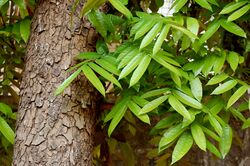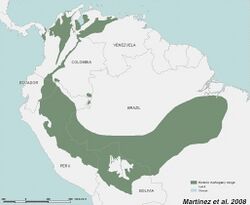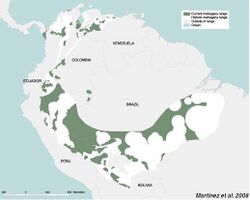Biology:Swietenia macrophylla
| Swietenia macrophylla | |
|---|---|

| |
| Scientific classification | |
| Kingdom: | Plantae |
| Clade: | Tracheophytes |
| Clade: | Angiosperms |
| Clade: | Eudicots |
| Clade: | Rosids |
| Order: | Sapindales |
| Family: | Meliaceae |
| Genus: | Swietenia |
| Species: | S. macrophylla
|
| Binomial name | |
| Swietenia macrophylla King
| |

| |
| Historic range of big-leaf mahogany in South America | |

| |
| Current range of big-leaf mahogany in South America | |
| Synonyms[2] | |
| |
Swietenia macrophylla, commonly known as mahogany,[3] Honduran mahogany,[3] Honduras mahogany,[4] or big-leaf mahogany[5] is a species of plant in the Meliaceae family. It is one of three species that yields genuine mahogany timber (Swietenia), the others being Swietenia mahagoni and Swietenia humilis. It is native to South America, Mexico and Central America, but naturalized in the Philippines , Singapore, Malaysia and Hawaii,[3][6] and cultivated in plantations and wind-breaks elsewhere.[7]
Description
Wood
Mahogany wood is strong and is usually a source for furniture, musical instruments, ships, doors, coffins, decors.[8]
Leaves
Mahogany is characterised by its large leaves (up to 45 cm long). The leaflets are even in number and are connected by a central midrib.[8]
Fruits
The fruits are called "sky fruits" because of its upwards growth towards the sky.[9] The fruits of mahogany can be measure to 40 cm in length, in a light grey to brown capsule. Each fruit capsule could contain 71 winged seeds.[8]
Seeds
The seeds of mahogany can reach 7 to 12 cm long.[8]
Timber
Unlike mahogany sourced from its native locations, plantation mahogany grown in Asia is not restricted in trade. The mahogany timber grown in these Asian plantations is the major source of international trade in genuine mahogany today. The Asian countries which grow the majority of Swietenia macrophylla are India , Indonesia, Malaysia, Bangladesh, Fiji, Philippines , Singapore, and some others, with India and Fiji being the major world suppliers. The tree is also planted in Laos PDR.[citation needed]
Medicinal use
It was scientifically studied for its various biological activities. [10] A detailed mechanism of action of apoptotic inducing effect on HCT116 human cancer cell line was elucidated. [11] Through solvent extraction and fractionation done on seeds of Swietenia macrophylla, the ethyl acetate fraction (SMEAF) was further examined for its neuroprotective activity and acute toxicity effects. [12] Various purified compounds derived from Swietenia macrophylla were further examined and was revealed to possesses potent PPARγ binding activity which might capable of stimulating glucose uptake in muscle cells. [13]
The ethyl acetate fraction from the seeds of Swietenia macrophylla (SMEAF) was studied for anti-inflammatory properties using lipopolysaccharide (LPS)-induced BV-2 microglia. SMEAF significantly attenuated the LPS-induced production of nitric oxide (NO), inducible nitric oxide synthase (iNOS), cyclooxygenase-2 (COX-2), tumour necrosis factor-α (TNF-α) and interleukin-6 (IL-6). SMEAF inhibited nuclear translocation of nuclear factor-kappa B (NF-κB) via the attenuation of IκBα phosphorylation. Moreover, SMEAF markedly suppressed phosphorylation of Akt, p38 Mitogen-activated protein kinase (MAPK) and Extracellular signal-regulated kinase 1/2 (ERK1/2) in LPS-induced BV-2 cells. Treatment with specific inhibitors for Akt, NF-κB, p38 and ERK1/2 resulted in the attenuation of iNOS and COX-2 protein expression. These findings indicated that SMEAF possesses anti-inflammatory activities in BV-2 cells by modulating LPS-induced pro-inflammatory mediator production via the inhibition of Akt-dependent NF-κB, p38 MAPK and ERK1/2 activation. These results further advocate the potential use of S. macrophylla as nutraceutical for the intervention of neurodegenerative and neuroinflammatory disorders.[14]
There are also claims of its ability to improve blood circulation and skin condition, as well as anti-erectile dysfunction.[15]
However, there are reports of liver injury or hepatotoxicity after consumption of Mahogany Seeds both in raw form[16] and raw seeds grind and pack in capsule form.[17] The severity of liver damage varies. There are also the report of single case kidney injury and polyarthralgia. In most cases, the liver function was recovered after stopping the consumption.[16] The exact mechanism of these adverse events is currently unknown.[18]
These cases that happened are the first reports of Swietenia Macrophylla seeds’ association with liver injury.[16] This may also due to over dosage and consumption of contaminated raw seeds which are never been thoroughly investigated. Based on acute oral toxicity studies of Swietenia Macrophylla seeds, the consumption of Swietenia Macrophylla by humans is safe if the dose is less than 325 mg/kg body weight. The usual dose of Swietenia Macrophylla prescribed in Malaysian folk-lore medicine is one seed per day.[19]
Population genetics
Mesoamerican rainforest populations show higher structure than in the Amazon.[20]
Common names
The species is also known under other common names, including bastard mahogany,[21] broad-leaved mahogany, Brazilian mahogany, large-leaved mahogany, genuine mahogany, tropical American mahogany, and sky fruit, among others.[citation needed]
- English - big leaf mahogany, large-leaved mahogany, Brazilian mahogany
- French - acajou à grandes feuilles, acajou du Honduras
- Spanish - caoba, mara, mogno
- Malayalam - Script error: The function "transl" does not exist.
- Tamil - Script error: The function "transl" does not exist. (தேன்கனி)
- Telugu - Script error: The function "transl" does not exist.
- Sinhala - Script error: The function "transl" does not exist. (මහෝගනි)
Historic distribution of mahogany from Mexico to southeastern Amazonia according to Lamb (1966). From Martinez et al. 2008.[citation needed]
Revised historic distribution of mahogany in South America based on expert surveys. From Martinez et al. 2008.[citation needed]
Historic distribution of mahogany in Mexico and Central America. From Calvo et al. 2000.[citation needed]
References
- ↑ Barstow, M. & Negrão, R. (2023). "Swietenia macrophylla". IUCN Red List of Threatened Species 2023: e.T32293A68104718. https://www.iucnredlist.org/species/32293/68104718. Retrieved 12 December 2023.
- ↑ "The Plant List: A Working List of All Plant Species". http://www.theplantlist.org/tpl1.1/record/kew-2601504.
- ↑ 3.0 3.1 3.2 {{citation | mode = cs1 | title = Swietenia macrophylla | work = Germplasm Resources Information Network (GRIN) | url = | publisher = [[Organization:Agricultural Research ServAgricultural Research Service (ARS), United States Department of Agriculture (USDA) | access-date = 5 November 2014 }}
- ↑ "Swietenia macrophylla". Natural Resources Conservation Service PLANTS Database. USDA. https://plants.usda.gov/core/profile?symbol=SWMA.
- ↑ Free, Chris (2012). "Home". SwietKing Research. http://www.swietking.org/.
- ↑ Cernansky, Rachel (August 2018). "How to plant a trillion trees" (in EN). Nature 560 (7720): 542–544. doi:10.1038/d41586-018-06031-x. ISSN 0028-0836. PMID 30158623. Bibcode: 2018Natur.560..542C.
- ↑ Agroforestry Guides for Pacific Islands. Permanent Agriculture Resources. 2000. p. 57. ISBN 9780970254405. https://books.google.com/books?id=sHU_902_pIYC.
- ↑ 8.0 8.1 8.2 8.3 admin. "Swietenia macrophylla: Big-leaf mahogany" (in en-US). https://www.frim.gov.my/colour-of-frim/swietenia-macrophylla-big-leaf-mahogany/.
- ↑ Moghadamtousi, Soheil; Goh, Bey; Chan, Chim; Shabab, Tara; Kadir, Habsah (2013). "Biological Activities and Phytochemicals of Swietenia macrophylla King". Molecules 18 (9): 10465–10483. doi:10.3390/molecules180910465. PMID 23999722.
- ↑ Moghadamtousi, Soheil; Goh, Bey; Chan, Chim; Shabab, Tara; Kadir, Habsah (2013). "Biological Activities and Phytochemicals of Swietenia macrophylla King". Molecules 18 (9): 10465–10483. doi:10.3390/molecules180910465. PMID 23999722.
- ↑ Goh, Bey Hing; Chan, Chim Kei; Kamarudin, Muhamad Noor Alfarizal; Abdul Kadir, Habsah (2014). "Swietenia macrophylla King induces mitochondrial-mediated apoptosis through p53 upregulation in HCT116 colorectal carcinoma cells". Journal of Ethnopharmacology 153 (2): 375–385. doi:10.1016/j.jep.2014.02.036. PMID 24613274.
- ↑ Sayyad, Mustak; Tiang, Ning; Kumari, Yatinesh; Goh, Bey Hing; Jaiswal, Yogini; Rosli, Rozita; Williams, Leonard; Shaikh, Mohd Farooq (2017). "Acute toxicity profiling of the ethyl acetate fraction of Swietenia macrophylla seeds and in - vitro neuroprotection studies". Saudi Pharmaceutical Journal 25 (2): 196–205. doi:10.1016/j.jsps.2016.05.002. PMID 28344469.
- ↑ Lau, Wai; Goh, Bey; Kadir, Habsah; Shu-Chien, Alexander; Tengku Muhammad, Tengku (2015). "Potent PPARγ Ligands from Swietenia macrophylla Are Capable of Stimulating Glucose Uptake in Muscle Cells". Molecules 20 (12): 22301–22314. doi:10.3390/molecules201219847. PMID 26703529.
- ↑ Supriady, Hadi; Kamarudin, Muhamad Noor Alfarizal; Chan, Chim Kei; Goh, Bey Hing; Kadir, Habsah Abdul (2015). "SMEAF attenuates the production of pro-inflammatory mediators through the inactivation of Akt-dependent NF-κB, p38 and ERK1/2 pathways in LPS-stimulated BV-2 microglial cells". Journal of Functional Foods 17: 434–448. doi:10.1016/j.jff.2015.05.042.
- ↑ "Home: ENVIS-Center of NBRI on Plants and Pollution". http://nbrienvis.nic.in/.
- ↑ 16.0 16.1 16.2 Ming Fock, Kwong; Kiong Teo, Eng; Vasudevan, Archana; Wah Soe, Wint; Yee Leong, Wai; Joanna (2018-09-01). "42. Consumption of Swietenia macrophylla seeds can lead to hepatitis and autoimmune phenomena" (in en). Rheumatology Advances in Practice 2 (suppl_1). doi:10.1093/rap/rky034.005. https://academic.oup.com/rheumap/article/2/suppl_1/rky034.005/5104012.
- ↑ "HSA Updates on Reports of Liver Injury After Consumption of Mahogany Seeds (Sky Fruit)". Health Sciences Authority Press Release. 11 December 2018. https://www.hsa.gov.sg/content/dam/HSA/News_and_Events/Press_Releases/2018/HSA%20PR_Mahogany%20seeds_final.pdf.
- ↑ "CHP investigates suspected cases of hepatotoxicity after consumption of sky fruit seeds and related products". https://www.info.gov.hk/gia/general/201902/26/P2019022600720.htm.
- ↑ Balijepalli, Madhu Katyayani; Suppaiah, Velan; Chin, An-me; Buru, Ayuba Sunday; Sagineedu, Sreenivasa Rao; Pichika, Mallikarjuna Rao (2015). "Acute oral toxicity studies of Swietenia macrophylla seeds in Sprague Dawley rats". Pharmacognosy Research 7 (1): 38–44. doi:10.4103/0974-8490.147197. ISSN 0976-4836. PMID 25598633.
- ↑ Pennington, R. Toby; Lavin, Matt; Oliveira-Filho, Ary (2009). "Woody Plant Diversity, Evolution, and Ecology in the Tropics: Perspectives from Seasonally Dry Tropical Forests". Annual Review of Ecology, Evolution, and Systematics (Annual Reviews) 40 (1): 437–457. doi:10.1146/annurev.ecolsys.110308.120327. ISSN 1543-592X.
- ↑ Flowers of India: Big-leaf mahogany
External links
Wikidata ☰ Q12955947 entry
 |












